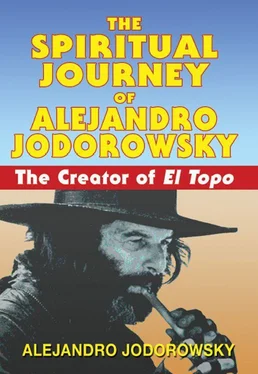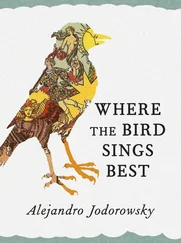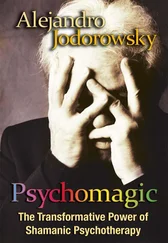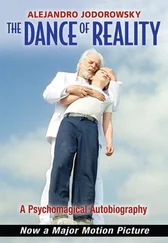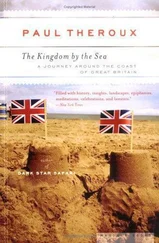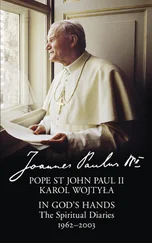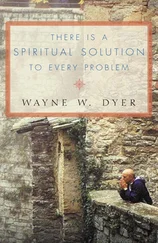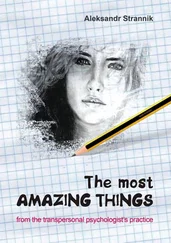I was tense and seemingly at a total loss for words when suddenly I heard myself say: “Mr. Welles, during the entire month that the filming of your role will require, I promise you to hire the head cook of this very restaurant. Every evening, he will prepare all the dishes you desire accompanied by any wines and liquors that please you.”
With a big smile, he agreed to sign the contract.
For the combat scenes in Dune , I hired the karate master Jean-Pierre Vigneau, a huge man with muscles of steel. He was teaching martial arts to my son Brontis, who had the lead role of the young Paul Atreides. One day, in front of my son and other students, he decided to challenge me.
“You are an artist, which is an admirable profession. But I wonder — would that wonderful intellect of yours that you rely on so much be of the slightest use to you in surviving a direct attack by a dangerous enemy?” And then he stepped up to me and assumed a position of attack.
To me, this man was invincible. I had watched him demolish several karate champions. I decided to accept the playful duel, knowing that I was bound to lose. Suddenly, I leaped into the air and hung upon him, holding on to him like a baby holding on to its mother’s breast. I let him shake me violently, offering no resistance. Then he set me down and used all his weight and strength to put me in a stranglehold. Impulsively, having no idea why I was doing it, I made a delicate movement with my hand and inserted my little finger into his ear. Immediately, Jean-Pierre slapped the floor in the classic signal of surrender!
He arose and announced to everyone: “That’s the first time I’ve lost a fight. I’m sure my adversary didn’t realize it, but he found a fatal point with his finger. By shoving your little finger with enough force into an enemy’s ear, you can pierce through the eardrum and kill him.”
After two years of intense work in Paris, just when it seemed that Dune was finally about to be completed, the producer abruptly aborted the project. It was a dreadful blow to all of us. Dan O’Bannon, the future special effects director, returned to Los Angeles so stressed he had to spend two years being treated in a psychiatric clinic. Giger, the painter hired to design the sets, raged angrily at me about this “failure.” I refused to let myself be brought down by this assault of reality.
As I told my friend, the artist Moebius who had worked on costume designs and also designed the three thousand images used in the film: “Failure does not exist. It is a concept of the mind. Instead, let us call this a change of path .”
And then, because we could no longer express our visions in cinematic form, I proposed we work together on graphic novels. Thus was born the success of The Incal .
Shortly after his twelfth birthday, my son Cristobal told me he didn’t want to return to his school at St. Mandé. I asked him whether he was bored with the studies or with the teachers.
“No, it’s not that. It’s that I’ve been humiliated.”
Then, between two sobs, he told me the story. The biggest and strongest kid in the school, Albert, was jealous because a girl he liked preferred the company of my son. This Albert had pasted photocopies of a sort of poster on the walls of the school and courtyard: it displayed Cristobal’s photo and the words dwarf, jew, and thief. Now the other students were laughing at him.
“This is a koan,” I told him. “Don’t run away from the situation; instead, solve it. You must find a way to punish your enemy and restore your dignity with the other students.”
“But how? He’s a lot stronger than I am. If I fight him, he’ll smash my face in. It’s just the excuse he’s looking for.”
“Cristobal, not all fights are equal. That’s why strategy is important. You must strike him at a time and in such a way that he can’t defend himself.”
I helped him work out a plan. The next day, Cristobal returned to school. He waited until Albert, who was in a more advanced class, had entered a classroom with his fellow students. When he knew they were all seated, he opened the door without permission, ignored the teacher, walked straight over to where Albert was sitting, and began to administer a flurry of violent slaps to his face. The sheer surprise of this paralyzed Albert. By the time he started to react, the scandal already had the class in an uproar. He and Cristobal were held immobile by the other boys, and the teacher, who was both very angry and intrigued, led both boys to the principal’s office.
Cristobal showed the principal a copy of the poster and complained of being publicly humiliated and racially slandered. He stated that he had slapped Albert in order to regain his self-esteem. The principal reacted by summoning Albert’s parents and threatening to expel him from the school. Still following our strategy, Cristobal said that he would be willing to forgive Albert on condition that the boy apologize in public. Albert offered his apology before an assembly of the student body in the courtyard.
At the Cannes Film Festival, the producer Claudio Argento organized a press conference for me to present the project of my next film, Santa Sangre . More than ten years had passed since The Holy Mountain . The journalists there regarded me as a has-been filmmaker. One of them opened the discussion with a nasty remark:
“Do you think you can still shoot a film? After all, you’re a little rusty.”
“A rusty knife has a double power,” I replied. “At the same time it cuts, it poisons.”
I was shooting Santa Sangre right in the middle of Garibaldi Plaza in Mexico City when the idea came to me to have a blind choir sing a religious hymn in the scene we were going to film the next day inside the church. My casting director told me it was impossible to find a blind choir on such short notice. At the end of the day’s work, I decided to walk back to my hotel. A blind man carrying a guitar walked toward me, and his cane tapped against my leg. He excused himself and went on. Suddenly, I realized that this was an example of what I have always believed: accidents are miracles in disguise. I ran after the man, stopped him, and asked him if he knew any religious songs.
“Of course I do,” he answered. “I’ve even composed one. I belong to a choir of blind musicians. There are thirty of us, and we are all Protestants. Right now, I’m going to a rehearsal.”
I went with him. The thirty blind people, each playing a guitar, sang a hymn that began, “The end of the world is almost here. .” The next day, my casting director was flabbergasted to see them arrive at the church for the filming.
When Santa Sangre premiered in Rome, some journalists asked me which film director had most influenced me.
“Fellini,” I answered without hesitation. When I was very young, it was his film La Strada that first made me feel I wanted to be a film director someday.
This homage appeared in the press, and one of the master’s secretaries telephoned me to say Fellini would like to meet me. I was invited to come that very evening to watch the shooting of a scene from La voce della luna . A car arrived to pick me up and take me to a huge vacant lot outside the city. Very shyly, I walked toward a group of technicians working in the shadows and getting ready to plug in the projectors. Then a shadow that seemed huge headed toward me with open arms. I recognized Fellini.
“Jodorowsky!” he exclaimed, with a great smile.
On the verge of tears, I answered, “Papa!” and we embraced.
At that instant, a torrential rain began to fall. Amid the great disorder and consternation of this, we both ran for shelter along with all the actors and technicians. I lost sight of him and never saw him again, but that brief exchange of two words is one of my most treasured memories.
Читать дальше
